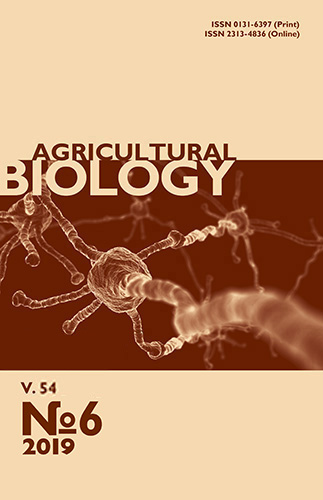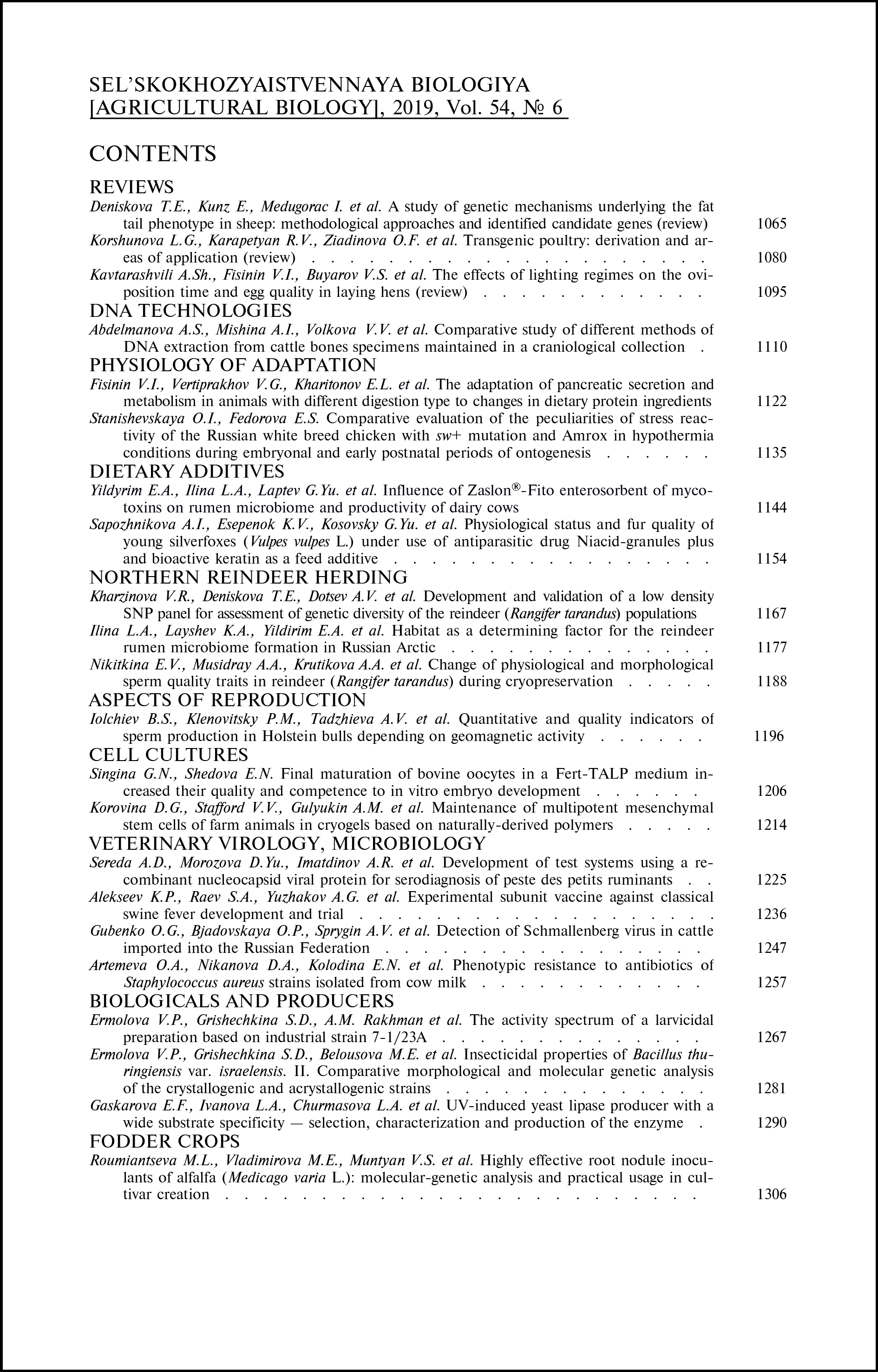doi: 10.15389/agrobiology.2019.6.1196eng
UDC: 636.2:591.16:612.616.2
Acknowledgements:
Supported financially by Russian Foundation for Basic Research, grant No. 18-016-00128 А
QUANTITATIVE AND QUALITY INDICATORS OF SPERM PRODUCTION IN HOLSTEIN BULLS DEPENDING ON GEOMAGNETIC ACTIVITY
B.S. Iolchiev1, P.M. Klenovitsky1, A.V. Tadzhieva2, R.B. Iolchiev3
1Ernst Federal Science Center for Animal Husbandry, 60, pos. Dubrovitsy, Podolsk District, Moscow Province, 142132 Russia, e-mail baylar2@mail.ru (✉ corresponding author), klenpm@mail.ru;
2People’s Friendship University of Russia (RUDN University), 6, ul. Miklukho-Maklaya, Moscow, 117198 Russia, e-mail anna74@list.ru;
3Yevdokimov Moscow State University of Medicine and Dentistry, 4, ul. Dolgorukovslaya, Moscow, 127473 Russia, e-mail rust1906@yandex.ru
ORCID:
Iolchiev B.S. orcid.org/0000-0001-5386-7263
Tadzhieva A.V. orcid.org/0000-0002-8108-7149
Klenovitsky P.M. orcid.org/0000-0003-2266-1275
Iolchiev R.B. orcid.org/0000-0003-1248-114X
Received July 13, 2019
A magnetic storm is one of the most important factors affecting the biological objects. The magnetic storms have profound effects at the molecular level, affecting certain cell structures. Spermatozoa are affected by various biotic and abiotic factors inside and outside the body. During the period of geomagnetic activity, the frequency of exacerbations of chronic diseases increases, the functions of a number of systems are disrupted. However, the reports on the influence of geomagnetic activity on the reproductive function, in particular on the quantity and quality of sperm, are objectively quite limited, and for agricultural species of animals such information was not found in the available literature. The objective of the work was to study the relationships between the geomagnetic activity and the sperm production quality and quantity parameters. The subject to the survey was the sperm collected from the Holstein-Friesian bull sires (n = 10, Joint-Stock Company “Head Center for the Reproduction of Farm Animals”, Moscow Province, 2018). Monitoring the K-index reflecting the geomagnetic conditions was carried out according to the data from the Pushkov Institute of Terrestrial Magnetism, Ionosphere and Radio Wave Propagation RAS. The statistical analysis was performed with SPSS v.15.0 for a one-way analysis of variance. The variables between the groups for К £ 1.0 (no geomagnetic disturbance) and K ≥ 5.0 (geomagnetic storm) were compared with the Scheffe’s test. The assessment of the sperm quality was performed with the Argus-CASA software (ArgusSoft, Russia) with Nikon Eclipse Ni microscope (Nikon, Japan). Our data indicate that during the survey, the K-index was a factor affecting the biological adequacy of the bull sires. The results prove that the magnetic storm has a significant impact on the qualitative and quantitative parameters of the bull sire sperm production. We have established the statistically valid criteria for the ejaculate volumes (F = 6.49; p < 0.05) and the progressively motile sperm number (F = 8.36; p < 0.05) per ejaculate. The volume of the ejaculates of the bull sires tends to a 28.2 % decrease (p < 0.001) during the magnetic storm period (K-index value ≥ 5.0 vs. K-index ≤ 1.0). The geomagnetic activity causes a 11.3 % decline (p < 0.001) in the sperm activity.
Keywords: magnetic storm, spermatozoa, sperm motility, morphology, chromatin, nDNA, DNA fragmentation index, bull sires, CASA.
REFERENCES
- Liboff A.R. The electromagnetic field as a biological variable. In: On the nature of electromagnetic field interactions with biological systems. A.N. Frey, R.J. Langes (eds.). Austin, 1994: 59-72.
- Binhi V.N., Prato F.S. Biological effects of the hypomagnetic field: an analytical review of experiments and theories. PLoS ONE, 2017, 12(6): e0179340 CrossRef
- McCraty R., Atkinson M., Stolc V., Alabdulgader A.A., Vainoras A., Ragulskis M. Synchronization of human autonomic nervous system rhythms with geomagnetic activity in human subjects. Int. J. Environ. Res. Public Health, 2017, 14(7): 770 CrossRef
- Halberg F., Cornelissen G., McCraty R., Al-Abdulgader A.A. Time structures (chronomes) of the blood circulation, populations’ health, human affairs and space weather. World Heart Journal, 2011, 3(1): 1-42.
- Halberg F., Cornelissen G., Otsuka K., Watanabe Y., Katinas G.S., Burioka N., Delyukov A., Gorgo Y., Zhao Z., Weydahl A., Sothern R.B., Siegelova J., Fiser B., Dusek J., Syutkina E.V., Perfetto F., Tarquini R., Singh R.B., Rhees B., Lofstrom D., Lofstrom P., Johnson P.W., Schwartzkopff O., the International BIOCOS Study Group. Cross-spectrally coherent ~ 10.5- and 21-year biological and physical cycles, magnetic storms and myocardial infarctions. Neuro Endocrinology Letters, 2000, 21(3): 233-258.
- Khabarova O., Dimitrova S. On the nature of people’s reaction to space weather and meteorological weather changes. Sun and Geosphere, 2009, 4(2): 60-71.
- Foster K.R. Mechanisms of interaction of extremely low frequency electric fields and biological systems. Radiation Protection Dosimetry, 2003, 106(4): 301-310 CrossRef
- Cornélissen G., Halberg F., Breus T., Syutkina E.V., Baevsky R., Weydahl A., Watanabe Y., Otsuka K., Siegelova J., Fiser B., Bakken E.E. Non-photic solar associations of heart rate variability and myocardial infarction. Journal of Atmospheric and Solar-Terrestrial Physics, 2002, 64(5-6): 707-720 CrossRef
- Giannaropoulou E., Papailiou M., Mavromichalaki H., Gigolashvili M., Tvildiani L., Janashia K., Preka-Papadema P., Papadima T. A study on the various types of arrhythmias in relation to the polarity reversal of the solar magnetic field. Nat. Hazards, 2014, 70: 1575-1587 CrossRef
- Caswell J.M., Carniello T.N., Murugan N.J. Annual incidence of mortality related to hypertensive disease in Canada and associations with heliophysical parameters. Int. J. Biometeorol., 2016, 60: 9-20 CrossRef
- Panov G.A., Chizov A.Ya., Kotova I.N. Magnet storms influence on students’ functional systems. Vestnik Rossiiskogo universiteta druzhby narodov. Seriya: Ekologiya i bezopasnost' zhiznedeyatel'nosti, 2008, 1: 60-67 (in Russ.).
- Burch J.B., Reif J.S., Yost M.G. Geomagnetic disturbances are associated with reduced nocturnal excretion of a melatonin metabolite in humans. Neuroscience Letters, 1999, 266(3): 209-212 CrossRef
- Bergiannaki J.-D., Paparrigopoulos T.J., Stefanis C.N. Seasonal pattern of melatonin excretion in humans: relationship to day length variation rate and geomagnetic field fluctuations. Experientia, 1996, 52(3): 253-258 CrossRef
- Cipolla-Neto J., Amaral F.G.D. Melatonin as a hormone: new physiological and clinical insights. Endocrine Reviews, 2018, 39(6): 990-1028 CrossRef
- Pohanka M. Impact of melatonin on immunity: a review. Open Medicine, 2013, 8(4): 369-376 CrossRef
- Rocha C.S., Rato L., Martins A.D., Alves M.G., Oliveira P.F. Melatonin and male reproductive health: relevance of darkness and antioxidant properties. Current Molecular Medicine, 2015, 15(4): 299-311 CrossRef
- Lampiao F., Du Plessis S.S. New developments of the effect of melatonin on reproduction. World J. Obstet. Gynecol., 2013, 2(2): 8-15 CrossRef
- Agadzhanyan N.A., Makarova I.I. Ekologiya cheloveka, 2005, 9: 3-9 (in Russ.).
- Glinka M., Gawron S., SierońA., Pawłowska-Góral K., Cieślar G., Sieroń K. Impact of static magnetic field on the antioxidant defense system of mice fibroblasts. BioMed Research International, 2018, 2018: Article ID 5053608 CrossRef
- Zablotskii V., Polyakova T., Lunov O., Dejneka A. How a high-gradient magnetic field could affect cell life. Sci. Rep., 2016, 6: 37407 CrossRef
- Marshall D.J. Environmentally induced (co)variance in sperm and offspring phenotypes as a source of epigenetic effects. Journal of Experimental Biology, 2015, 218: 107-113 CrossRef
- Toraño E.G., García M.G., Fernández-Morera J.L., Niño-García P., Fernández A.F. The impact of external factors on the epigenome: in utero and over lifetime. BioMed Research International, 2016, 2016: Article ID 2568635 CrossRef
- Jensen N., Allen R.M., Marshall D.J. Adaptive maternal and paternal effects: gamete plasticity in response to parental stress. Funct. Ecol., 2014, 28(3): 724-733 CrossRef
- Li D.K., Yan B., Li Z., Gao E., Miao M., Gong D., Weng X., Ferber J.R., Yuan W. Exposure to magnetic fields and the risk of poor sperm quality. Reproductive Toxicology, 2010, 29(1): 86-92 CrossRef
- Kumari K., Capstick M., Cassara M., Herrala M., Koivisto H., Naarala J., Tanila H., Vilukselaa M., Juutilainen J. Effects of intermediate frequency magnetic fields on male fertility indicators in mice. Environmental Research, 2017, 157: 64-70 CrossRef
- Borunova S.M., Iolchiev B.S., Badmaev O.E., Tumilovich YA.I., Iolchiev P.B., Ribchenko A.S. Veterinariya, zootekhniya i biotekhnologiya, 2017, 11: 57-64 (in Russ.).
- Vinogradov V.N., Strekozov N.I., Abilov A.I et al. Natsional'naya tekhnologiya zamorazhivaniya i ispol'zovaniya spermy plemennykh bykov-proizvoditelei [National technology for freezing and using sperm of bulls sires]. Moscow, 2008 (in Russ.).
- Wang X., Yang C., Guo F., Zhang Y., Ju Z., Jiang Q., Zhao X., Liu Y., Zhao H., Wang J., Sun Y., Wang C., Zhu H., Huang J. Integrated analysis of mRNAs and long noncoding RNAs in the semen from Holstein bulls with high and low sperm motility. Scientific Reports, 2019, 9: Article number 2092 CrossRef
- Brody S.A. Andrologiya i genital'naya khirurgiya, 2014, 3: 33-41 CrossRef (in Russ.).
- Gonzalez-Marin C., Gosalvez J., Roy R. Types, causes, detection and repair of DNA fragmentation in animal and human sperm cells. International Journal of Molecular Sciences, 2012, 13(11): 14026-14052 CrossRef
- Kim G.Y. What should be done for men with sperm DNA fragmentation? Clin. Exp. Reprod. Med., 2018, 45(3): 101-109 CrossRef
- Agarwal A., Said T.M. Role of sperm chromatin abnormalities and DNA damage in male infertility. Human Reproduction Update, 2003, 9(4): 331-345 CrossRef
- Esteves S.C., Sanchez-Martin F., Sanchez-Martin P., Schneider D.T., Gosálvez J. Comparison of reproductive outcome in oligozoospermic men with high sperm DNA fragmentation undergoing intracytoplasmic sperm injection with ejaculated and testicular sperm. Fertility and Sterility, 2015, 104(6): 1398-1405 CrossRef












